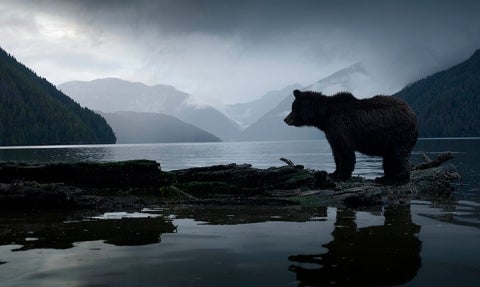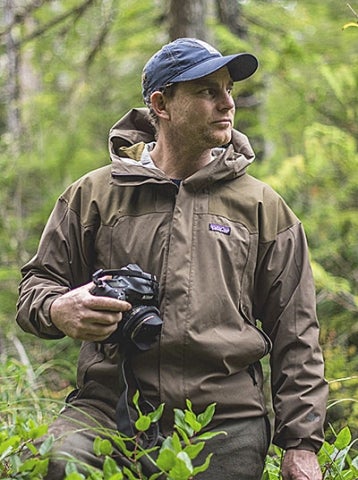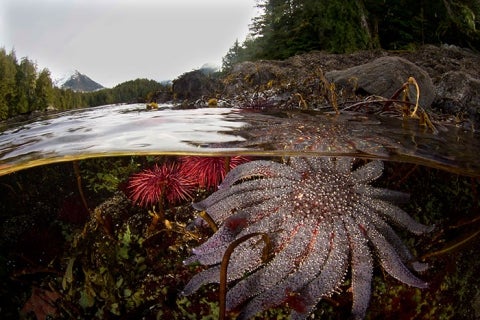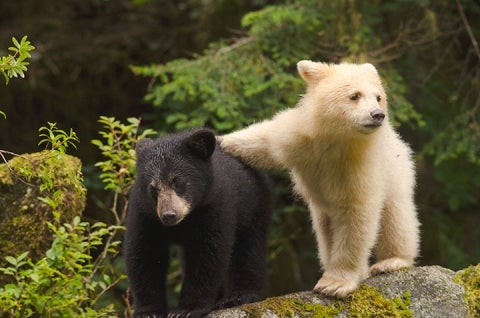Note: Yale School of the Environment (YSE) was formerly known as the Yale School of Forestry & Environmental Studies (F&ES). News articles and events posted prior to July 1, 2020 refer to the School's name at that time.
 <p class="p1"> A coastal grizzly bear in Great Bear Rainforest.</p>
<p class="p1"> A coastal grizzly bear in Great Bear Rainforest.</p>
The first time
Ian McAllister visited Great Bear Rainforest, a remote region of temperate rainforest on the coast of British Columbia, he planned to stay just a week. More than two decades later he’s still there. And he has no plans to leave.
Over 25 years, McAllister has become one of the greatest champions for Great Bear, a region known for its dazzling biodiversity — and for being one of the planet’s most endangered landscapes. A founder of the wildlife conservation organization
Pacific Wild, he is also an award-winning photographer and author of six books, including his most recent,
Great Bear Wild, a stunning collection of photographs and personal narrative.
On Feb. 24, McAllister
will share his stories and photos during a presentation at the Yale School of Forestry & Environmental Studies (F&ES). The event begins at 5 p.m. in Burke Auditorium.
In an interview, McAllister describes the stunning beauty that lured him to this region, how Pacific Wild is trying to protect it, and the role of photography in stirring public interest in the natural world.
 Ian McAllister
Ian McAllister
Q: You’ve said that you originally expected to stay in Great Bear for just a few days, but it obviously hasn’t worked out that way. What is about the region that pulled you in?
IAN McALLISTER: It was one of those twists in life that you don’t see coming. When I initially started working here, the main focus was mapping out the extent of the rainforest. There was certainly global concern over the plight of coastal temperate rainforests because they’re so rare to begin with: They’re found only in a few locations on the planet. At the time, we suspected that the British Columbia coast probably had more intact primeval coastal temperate rainforest than any other region on the planet, and since then that has proven correct. But it was also the most unprotected and endangered rainforest on the planet. The stated intent of the B.C. government at that time was to liquidate all of the rainforest in the Great Bear Rainforest. So it was very much a race against time.
Q: What role did you envision Pacific Wild playing?
McALLISTER: Our role has always been on the ground. Our foundation in conservation is primary fieldwork and research, and bringing that research — and photo imagery and footage and other creative components — to the outside world.
During those years were spent mapping out critical habitats and understanding the scale and scope of the contiguous salmon-producing river systems. And we worked with scientists and ecologists from around the world designing a conservation proposal for the entire region. And it quickly became very much an area of international focus and attention. And at the time, it was also considered the largest conservation proposal in North America’s history. So it was really exciting.
 <p class="p1"> A Sunstar, the largest of its type on the planet.</p>
<p class="p1"> A Sunstar, the largest of its type on the planet.</p>
We worked on a lot of different fronts. In addition to developing the scientific rationale to support a large scaled protected area, we worked with Fortune 500 companies in North America and in Europe to develop procurement policies that would get them away from sourcing old growth forest products. This put a tremendous amount of financial pressure on government and industry, and it really brought them to the table. And we worked on a lot of public campaigns around the world to bring attention to the issue; this eventually culminated in historic agreements known as The Great Bear Rainforest Agreements in which more than 30 percent of the old growth forests are protected.
Increasingly we have recognized that it’s really the ocean that fuels the productivity of the rainforest, and that there’s this seamless interface between ocean and rainforest. And the more we recognized how the ocean is providing so much for life, the more we understood that the Canadian government has done even a poorer job of protecting the marine environment. We’ve got one of the largest, most diverse, ecologically productive marine ecosystems in the world, and yet have done virtually nothing to protect it. And that’s very much the next frontier — and very much a large focus for Pacific Wild today.
Q: What kind of work is Pacific Wild doing on the ocean?
McALLISTER: We’re operating one of the largest acoustic hydrophone array on the B.C. coast, measuring ambient sound conditions and the acoustic environment. We’re attempting to develop acoustic thresholds that would be appropriate for acoustically sensitive marine mammals such as humpback whales, and orca and white-sided dolphins, et cetera. The reason for this is that the Great Bear Rainforest is now subject to some of the largest and most extensive pipeline proposals that are proposed to carry condensate, tar sands oil and natural gas to the rainforest here for shipping by tanker to Asia. So we recognize that this is such a critically important area for whales. Today these waters are acoustically pristine; there’s no anthropogenic noise or virtually no anthropogenic noise disturbing these whales. But if these proposals go ahead, it will increase the acoustic pollution in our oceans dramatically… If all the projects on the books right now were approved, it would increase tanker traffic significantly. And these are the nosiest ships in the world from almost zero to over 3,000 tanker trips a year..
Q: As you mentioned, an important part of the work you’re doing has been documenting these beautiful places on film. What came first, your passion for nature or your skills as a photographer?
McALLISTER: I guess I’m still trying to figure that one out. I just sort of grew up on the coast. And from a young age, I fell in love with the wild west coast. And it just seemed like a natural thing to do, to try to give back for the immense enjoyment that I’ve had through photography and film work and wildlife observation. It’s hard to imagine one without the other I suppose.
Q: What part do you see photography playing in calling attention to these special places?
McALLISTER: Photography certainly still plays a critical role in inspiring people to not only understand the natural world, but in making them to want to protect it. We’ve seen campaigns that have truly been changed by imagery. I know that when we first came to this coast there was really no images of it. And so we would return from these expeditions, and we’d travel to Europe and across the states, and we would talk about this incredible rainforest full of grizzly bears and salmon and whales and First Nations culture still intact. About traveling through unbroken rainforest for days upon days. But unless people can actually see it, it’s hard to imagine.
Q: Wildlife photography can be an incredibly difficult and physically taxing occupation. What are some of the tips you would give to younger photographers?
McALLISTER: Yes, it is challenging. I think I would suggest focusing on a certain niche and developing those stories. There are so many incredible stories still to be told around these spectacular natural history events that few people know about. And few have ever documented them. There are these incredible migrations of forage fish like eulachons that come into these large mainland coastal river systems in the springtime. And they spawn there. And they feed this huge diversity of life from grizzly bears to whales. And there are the great herring runs. And there’s so much unknown in the underwater world. The list goes on and on.
There’s no lack of subjects and stories to tell and to illustrate on this coast. But I think the most important thing is to stay focused and don’t just take pictures or shoot footage of the event. Develop a story that tells the cultural and long human history associated with these species and these cycles and the ecology and then you’re going to be successful.
 <p class="p1"> The British Columbia’s north coast is home to the globally rare Spirit bear.</p>
<p class="p1"> The British Columbia’s north coast is home to the globally rare Spirit bear.</p>
 <p class="p1"> A coastal grizzly bear in Great Bear Rainforest.</p>
<p class="p1"> A coastal grizzly bear in Great Bear Rainforest.</p>
 Ian McAllister
Ian McAllister
 <p class="p1"> A Sunstar, the largest of its type on the planet.</p>
<p class="p1"> A Sunstar, the largest of its type on the planet.</p>
 <p class="p1"> The British Columbia’s north coast is home to the globally rare Spirit bear.</p>
<p class="p1"> The British Columbia’s north coast is home to the globally rare Spirit bear.</p>